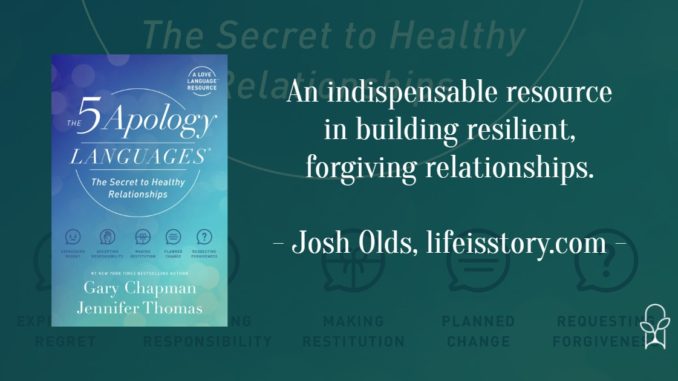
Also by this author: Holding on to Love After You've Lost a Baby: The 5 Love Languages for Grieving Parents, Loving Adopted Children Well: A 5 Love Languages® Approach, Loving Adopted Children Well: A 5 Love Languages® Approach
Published by Northfield Publishing on January 3, 2022
Genres: Non-Fiction, Christian Life
Buy on Amazon
Goodreads

“I said I was sorry! What more do you want?”
Even in the best of relationships, we mess up. We say and do things we deeply regret later on. So we need to make things right. But just saying you’re sorry isn’t enough. That’s only the first step on the road to restoration.
In The 5 Apology Languages, Gary Chapman, the #1 New York Times bestselling author of the 5 Love Languages®, partners with Jennifer Thomas to help you on the journey toward restored relationships. True healing comes when you learn to:
Express regret: “I’m sorry.”Accept responsibility: “I was wrong.”Make restitution: “How can I make it right?”Plan for change: “I’ll take steps to prevent a reoccurrence.”Request forgiveness: “Can you find it in your heart to . . . ?”Don’t let hurts linger or wounds fester. Start on the path to healing today and discover how meaningful apologies can make your friendships, family, and marriage stronger than ever before.
Imagine a scene with two children and one child does something to the other that’s intentionally or unintentionally mean or rude. Cuts in line. Takes their toy. Shoves them. You get the idea. We’ve all been there. And we know what’s likely to happen next. An adult makes the offender apologize to the offended.
Say you’re sorry.
The offender stares daggers at the offended. Sorry.
And the adult concludes that amends have been made. We’ve done the best we can, even though the offender wasn’t sorry, the offended feels no better, and the mediator knows that nothing of substance has changed.
When we become adults, we often don’t do any better. I’m sorry you were offended, seems to be a common non-apology. Silence is another. Or verbal apologies with no change in actions or behavior. Or even a sincere “my bad” but a refusal to take responsibility for the consequences. And like it was when we were kids, we often think we can’t do any better. But the truth is, we can—if we know how.
The 5 Apology Languages uses the framework of the now-classic The Five Love Languages, breaking down our desired response to offense into five categories. Unlike some other spinoffs, The 5 Apology Languages isn’t just the love languages repackaged into a new context (though I would be interested to see if certain love languages lend themselves to certain apology languages), it’s a whole new system that talks about five different ways to apologize.
- The first apology language is expressing regret. It’s about naming the problem, acknowledging it, and showing sorrow over it. In this this apology language, the offended primarily wants to know the offender understands the offense.
- The second is accepting responsibility. In this apology language, the offended wants to know that the offender is going to own their mistakes or bad behavior. This goes beyond naming the problem to admitting culpability and accepting the consequences.
- The third language is making restitution. Similar to taking responsibility, this apology language looks for a practical response. How can the wrong be righted?
- The fourth apology language is planning to change. Chapman and Thomas note that many people are quick to apologize but slow to change their behavior. In this language, the offended want to know what steps the offender will take to avoid a repeat offense.
- The fifth is requesting forgiveness. This one rounds off the languages by putting power back into the hands of the offended. It is about showing humility, understanding the need for forgiveness, and verbally asking the offended for it.
As you can see, the 5 apology languages are not exclusive to one another. Responsibility may be inherently tired to restitution. In fact, if you look at the structure of the languages, you can see how a good apology will actually incorporate all five apology languages. And that’s not just to make sure you’re heard. It’s a sequential step-by-step method of a full, robust, sincere apology. Regret leads to responsibility leads to restitution leads to change and concludes with a desire to receive forgiveness.
Chapman and Thomas also make it clear that it’s important to apologize with the other person’s primary apology language. It’s not about going through the motions or checking items off a list, it’s about communication and understanding, caring for a person in the way they prefer to be taken care of. Another great point is that one can apologize for things they didn’t mean to do. You can sincerely and genuinely apologize for unintentional offenses.
Some of the Love Languages spinoffs have been little more than The Five Love Languages repackaged. The 5 Apology Languages stands on its own separate from Chapman’s other work and offers a simple, yet profound breakdown of how to communicate apology. Filled with personal anecdotes and vignettes, the book is readable, conversational, and practical. You’re going to see yourself in this book.
And if that’s not enough, the book ends with a 5 Apology Languages test to see what language you identify with the most. Interestingly, I found myself asking differently based on relational context. What I want out of an apology from my wife might be different from what I want out of a coworker, employer, stranger, or government. With so much miscommunication in relationships, The 5 Apology Languages will be an indispensable resource in building resilient, forgiving relationships.
As an addendum, it’s worth mentioning that this is not a brand new publication, but an updated and revised edition of The Five Languages of Apology and When Sorry Isn’t Enough.
